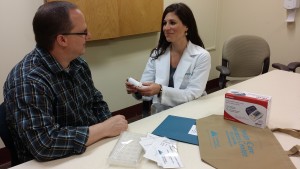
Conemaugh Memorial Medical Center PCRC transition-of-care pharmacist Meghan L. Bolinger, PA-C, Pharm.D., BCACP, demonstrates proper inhaler use for a patient.
THE GROWTH OF MULTIDISCIPLINARY AMBULATORY CARE CENTERS that prominently feature pharmacists is helping to transform patient care across the U.S. At six hospitals and health systems in Pennsylvania, Primary Care Resource Centers (PCRCs) are bridging the gap from hospital to home.
Each PCRC is a hospital-based hub staffed by three nurse care managers, a pharmacist, and administrative support. The ultimate aim is to reduce avoidable hospital readmissions for three health conditions that drive the majority of readmissions in western Pennsylvania: chronic obstructive pulmonary disease (COPD), heart failure (HF), and acute myocardial infarction (AMI).
“What sets PCRCs apart from other transitional care teams is that this model puts a pharmacist at the center,” said Keith T. Kanel, M.D., MHCM, FACP, project director and PHRI’s chief medical officer.
“In most other models, nurses and advanced practice nurses make up the core,” he noted. “Nurses are critical, of course, but so are pharmacists, because medication management plays a major role in the treatment of this patient population.”
A nonprofit collaborative, the Pittsburgh Regional Health Initiative (PRHI) developed the PCRC model using a three-year, $10.4 million grant from the Center for Medicare and Medicaid Innovation.
In each PCRC, pharmacists counsel patients about their illnesses and drug therapies, conduct a thorough medication review and reconciliation, and construct a home action plan with physician input.
After discharge, caregivers follow up by phone (or with a home visit if necessary) to resolve any medication issues. They also ensure that patients can get in touch with their medical care team.
PCRC Success Leads to Innovation
At Conemaugh Memorial Medical Center, a 555-bed community hospital in Johnstown, the need for pharmacist care was dramatic. Soon after the Conemaugh PCRC opened, monthly admissions of patients eligible for care at the center jumped 18 percent. But the lone pharmacist on the team struggled to keep up with the added patient load, and the number of pharmacist-patient encounters remained flat.

From left, Conemaugh pharmacy technician Amber Fink, CPhT, reviews a patient’s medication records and regimen with Dr. Bolinger.
“It was quickly evident that I needed assistance to accomplish our goals in face-to-face patient interactions,” said Meghan L. Bolinger, PA-C, Pharm.D., BCACP, a PCRC transition-of-care pharmacist.
“My time was stretched thin taking care of nonclinical tasks, such as manually entering patient medications into the outpatient provider database. I often felt rushed because I was doing so much recordkeeping,” she added.
Although funding limitations meant that hiring a second pharmacist was not possible, the Conemaugh PCRC could support a full-time technician. In May 2014, eight months after the PCRC opened, certified pharmacy technician Amber Fink, CPhT, joined the center and was trained to handle a range of responsibilities. These include documenting patients’ medication records, locating pertinent laboratory and diagnostic tests, maintaining the active patient roster and pending discharges, assembling patient medication education cards, and noting discrepancies among incompatible medication record systems.
Ms. Fink even made some home visits to organize patients’ pill boxes and conduct medication reviews. On the administrative side, she managed patient submissions of medication assistance forms, coordinated hospital-to-home program vouchers, transmitted the pharmacist’s care notes to primary care physicians, and monitored the impact of her own activities on the pharmacist’s workload and efficiency.
What sets PCRCs apart from other transitional care teams is that this model puts a pharmacist at the center.
The impact of an added technician was dramatic: After only a few months, the number of patients who received a comprehensive medication review increased nearly 20 percent, and the average chart review time decreased 41 percent – from about half an hour to under 20 minutes.
“Amber reviewed and cleaned up the charts in advance, so I was able to get through the information quickly and efficiently,” said Dr. Bolinger. “I was definitely able to do far more than I ever would have imagined if I had been here by myself.”
Conemaugh has committed to keeping its pharmacy technician on the staff, and the other hospitals are considering adding technicians to their PCRCs.
Adding a pharmacy technician to the PCRC team turned out to be “a great way to expand Dr. Bolinger’s reach and help her to practice at the top of her license,” said Toni Fera, Pharm.D., PCRC consulting pharmacist at the PRHI. “I think that says it all.”
Immediate and Lasting Success
The PCRC model ensures that the nurses and pharmacists are well-prepared for the patient care roles in which they serve. More than 8,000 hours of personnel training on quality improvement, motivational interviewing, and project management set the stage for success, according to Dr. Kanel. And the numbers bear out the PCRCs’ effectiveness. Between July 2013 and October 2015, the six PCRCs:
- Managed more than 14,000 hospital discharges of patients with COPD, HF, or AMI.
- Enrolled nearly 9,000 unique patients into longitudinal care plans.
- Logged 40,541 face-to-face contacts with hospitalized patients for care management, education, medication reconciliation, self-management skill building, and advance directive planning.
- Made more than 28,000 telephone calls to (or on behalf of) patients.
- Conducted more than 2,300 outpatient visits to patients’ homes or post-acute care facilities.
As a result of this intense set of interventions, PRHI’s 30-day all-cause readmission rate for the three target conditions fell from 20.4 percent to 15.3 percent, for a net readmission reduction of 25.0 percent.
The collaborative is now conducting a detailed analysis of return-on-investment, multi-payer benefit, patient subgroup analysis, and long-term financial savings as well.
Considering the Future
As the grant winds down, five of the six hospitals that established a PCRC, including Conemaugh, have announced that they will sustain their centers.
“In today’s world, most healthcare occurs out of the hospital. We wanted to find a way to fill the gaps that existed with our current systems, and I think we’ve been very successful,” said Dr. Kanel. “The PCRC is a worthy solution for community hospitals trying to manage complex patient populations. We would love to see this model adopted widely.”
–By Steve Frandzel









 If you want to contribute tutorials, news or other stuff please contact us. We pay 150 for each approved article.
If you want to contribute tutorials, news or other stuff please contact us. We pay 150 for each approved article. Consectetur adipisicing elit. Sed do eiusmod tempor incididunt ut labore.
Consectetur adipisicing elit. Sed do eiusmod tempor incididunt ut labore. This site uses valid HTML and CSS. All content Copyright © 2010 Newscast, Inc
This site uses valid HTML and CSS. All content Copyright © 2010 Newscast, Inc If you like what we do, please don't hestitate and subscribe to our
If you like what we do, please don't hestitate and subscribe to our